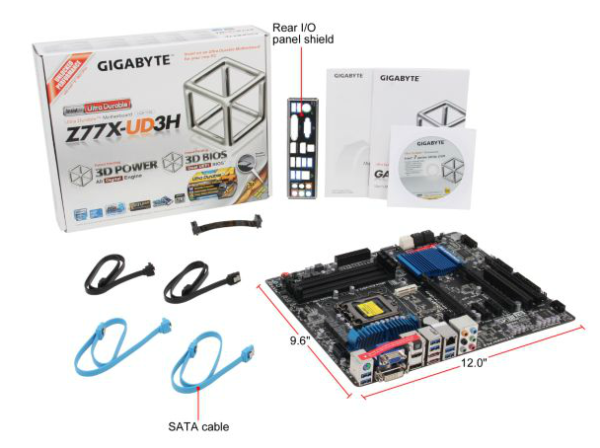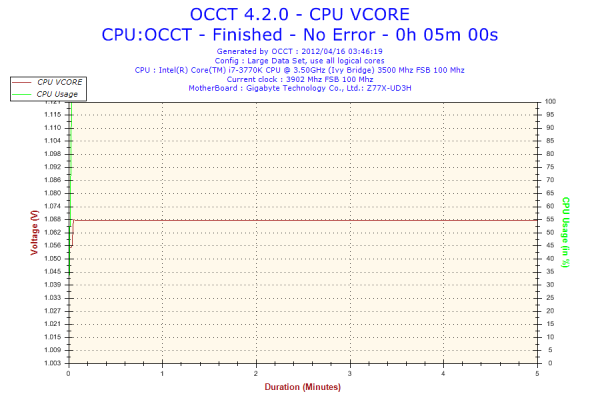Intel Z77 Motherboard Review with Ivy Bridge - ASRock, ASUS, Gigabyte, and MSI
by Ian Cutress on May 7, 2012 7:40 PM EST- Posted in
- Motherboards
- MSI
- Gigabyte
- ASRock
- Asus
- Ivy Bridge
- Z77
Gigabyte GA-Z77X-UD3H - In The Box
Over the past several motherboard generations, I have not been that impressed with Gigabyte's offering in terms of extras - this is because in order to hit a price point, sometimes the extras in the box are not the focus of the product. With the Z77X-UD3H, we are hoping for at least some good stuff here.
Driver CD
User Manual
IO Shield
Four SATA Cables
One long SLI bridge
Voltage Readings
Using OCCT we monitor the voltage change of the motherboard under load. This represents the direct correlation between the Load Line Calibration and how the processor/motherboard deals with voltage requests while under load. This is not to be confused with the quality of power delivery, but more an indication of how aggressive the default LLC settings are on a motherboard.
The response of the Gigabyte board under load is fantastic. No ripple at all and a lower average voltage than the ASUS P8P77-V Pro.
Overclocking
Note: Ivy Bridge does not overclock like Sandy Bridge. For a detailed report on the effect of voltage on Ivy Bridge (and thus temperatures and power draw), please read Undervolting and Overclocking on Ivy Bridge.
The Gigabyte GA-Z77X-UD3H has a variety of overclocking tools at the disposal of the user. Automatic overclocks are through EasyTune6, where we experienced a rather good result with our chip with Gigabyte's auto tuning software, and manual overclocks are either performed through the BIOS (with a series of menu jumps which should have been more carefully laid out), or using a new Gigabyte tool called TweakLauncher. I have not previewed TweakLauncher here, as it is primarily for sub-zero overclockers wanting real-time access to changes in performance while under extreme temperatures. It forgoes the usual GUI interface and sliders with something more amenable to the competitive overclocker - it is not suitable for the majority of users.
Auto Overclock: Using the Auto Tuning option in EasyTune6, the software pulled up a large screen and offered a confirmation of a stress-tested overclock. When clicked yes, the system would stability test a range of BCLK and Multipliers until the board resets or the system finds it unstable. When this had finished, the board offered me a 46x104.5 overclock (4810 MHz). I discovered that turbo modes still applied, so this speed was the single thread speed, and the CPU would reduce the multiplier by two for multithreaded loads, giving 4589 MHz). This gave 1.236 volts at load, which could be a little high, but due to the lower speed under multithreaded load, the CPU only reached 84ºC under PovRay and was completely stable. I enjoyed this result a lot from an automatic overclock!
Manual Overclock: Due to the way Ivy Bridge behaves with increased voltage, for a manual overclock, I am testing the peak overclock at a variety of voltages as well as the temperatures at that voltage. On the Gigabyte board, the CPU load line calibration was set to Extreme and Intel Speed Step was disabled. One interesting thing to note was that Gigabyte set this board to 100.9 MHz default on the BCLK, rather than 100.0 MHz. When the multiplier is pushed above 44x, this is reduced to 100.0 MHz.
At 1.100 volts, the highest multiplier that was stable was 45x, giving 4.5 GHz. This gave 70ºC at load with PovRay, and showed a load voltage of 1.116 volts.
At 1.150 volts, the highest multiplier that was stable was 46x, giving 4.6 GHz. This gave 75ºC at load with PovRay, and showed a load voltage of 1.164 volts.
At 1.200 volts, the highest multiplier that was stable was 47x, giving 4.7 GHz. This gave 82ºC with PovRay, 86ºC with OCCT, and a load voltage of 1.212 volts.
At 1.250 volts, the board successfully booted at 4.8 GHz, with 1.272 volts under load and 89ºC with PovRay - but this was not stable due to the memory errors in PovRay, suggesting more voltage is required. Given the current load temperature, I was unwilling to push the voltage further.
In terms of memory, when attempting to overclock a G.Skill 2x4 DDR3-2666 kit, which performed 2950 MHz on the ASUS P8Z77-V Pro, it would not boot at the DDR3-2800 strap despite all the correct timings being entered.












117 Comments
View All Comments
Zoomer - Monday, May 14, 2012 - link
Construction quality analysis would be a good addition, imo. Perhaps the mobo roundups can be done by a team instead of just 1 person. ;)457R4LDR34DKN07 - Monday, May 7, 2012 - link
I am always impressed by the depth of reviews by AT. I can't wait for the mITX roundup!P.S. any comment on availability of i7 3770t?
ltcommanderdata - Tuesday, May 8, 2012 - link
http://www.geeks3d.com/20120506/intel-hd-graphics-...It turns out Intel's new Windows 8 beta driver (v2729) works for Windows 7 and enables OpenGL 4.0 and OpenCL 1.1 support for Ivy Bridge. Can you try your OpenCL Compute benchmarks on them? Perhaps a OpenGL Unigine run as well to test OpenGL tessellation?
althaz - Tuesday, May 8, 2012 - link
So glad to finally get a tech site benchmarking POST times. One point of constructive criticism: I realise this would take more time, but ideally it'd be good to benchmark POST times both at default settings AND with everything possible disabled, so that we can get a true comparison between boards. Even with all features disabled, I've come across older boards where there is still 10+ seconds of difference in POST times.All in all, thanks for a great review!
ZeDestructor - Tuesday, May 8, 2012 - link
"The ASUS P8Z77-V Pro retails at $225-$235, essentially $100 less than the ASRock Z77 Extreme4" Should be "$100 more", not "$100 less"adrien - Tuesday, May 8, 2012 - link
I really wish 10GbE was on mainstream motherboards but I think you've mixed bits and Bytes here. ;-)Casper42 - Tuesday, May 8, 2012 - link
10Gbase-T is a power hog and requires special cabling if memory serves me right.DAC by way of SFP+ is too short and too expensive.
Fiber transceivers cost more than any of these entire motherboards.
How do you propose they get there?
There is a Broadcom chip that does 2.5Gbps when connected to a 10Gb switch and 1Gbps on a 1Gb switch. Maybe that's a good compromise
Metaluna - Tuesday, May 8, 2012 - link
I agree it seems unlikely that 10GbE over copper will ever reach sufficient critical mass to be economical for consumers, especially with wireless standards continually improving. Maybe Thunderbolt is the way forward for small high performance wired SANs in the home?Zoomer - Tuesday, May 15, 2012 - link
Thunderbolt is not the answer, due to limited range.theSeb - Tuesday, May 8, 2012 - link
Yep, since MBps is used correctly for the USB 2 and USB 3 charts I was surprised to see 400 megabytes per second over a gigabit ethernet link. :)